by Mary Bailey
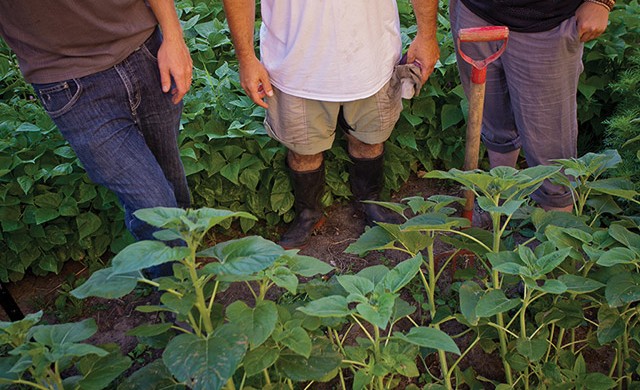
There is a revolution going on.
A garden revolution. We’re not alone; it’s happening all over North America. It’s happening in front yards and back, on vacant lots, on rooftops and in the field. Armed with runner beans and watering cans, people are gardening for social justice; some are gardening for a living; some do it for community. Others grow for research, or so they can pick fresh vegetables for dinner.
Whatever the reason, people are changing what it means to grow a garden. That change has the potential to transform our city with front yard gardens, food forests, farms on vacant lots and more community gardens.
Urban Farmers
Urban farms are nothing new. Endangered perhaps, yet a vital part of our landscape, such as Riverbend Gardens in the north end agricultural corridor. The newish wrinkle in urban gardening is the SPIN (small plot intensive) market garden farming practised by Lactuca and Reclaim Urban Farm. A landowner permits the gardener to work a piece of land (often a backyard) for a share of the produce. The rest is sold in a CSA or at a farmer’s market.
Calgary has, at last count, 14 SPIN operations. Kelowna, with its milder climate, has been home to several successful SPIN gardens for many years, actively supported by the restaurant community. Why Calgary has so many more than Edmonton is not clear. Ryan Mason of Reclaim Urban Farm thinks it may be because of the pioneering skills-building Verge Permaculture has done in Calgary. Perhaps our perennial labour shortage and lack of clarity around zoning also has something to do with it.
As far as zoning is concerned, there isn’t. Current zoning requires that a vacant lot be vacant until it is built on. For example, Reclaim’s Garneau site was previously a parking lot; also not considered a proper use as the land is zoned R9, the most dense residential use. Reclaim is confident that they’ll work through the zoning tangle with the city. I’d rather rows of veg than a weedy vacant lot. How about you?
Market Gardens
“I took the rototiller by bicycle today,” says Ryan Mason of Reclaim Farm.
The rototiller up to this point had been a problem. Ryan and his business partner Cathryn Sprague like to do everything by bicycle, yet heavy equipment was proving to be a challenge up until today.
They move around their 15 plots in the Whyte Avenue, Bonnie Doon and King Edward Park areas of the south side by bike, hauling the harvest in Rubbermaid totes, starting with the furthest away. It’s about a half acre in total, from which they pull about 100 pounds of greens every week and 30-50 pounds of other things. “We plant every single week; with each yard averaging three plantings a year,” says Ryan. They grow 20 varieties of greens; kale, spinach, arugula, minutina, sorrel, beet greens, dark red leaf lettuce, mustard greens, scarlet frills, romaines and cos, mache, a red-veined sorrel called bloody doc, and lots of herbs; dill, cilantro, sage, parsley, Thai basil, lemon balm, golden frond fennel, and sell it at the Downtown Farmers Market and to a couple of restaurants. “The nice thing about the market is that the conversation helps to sell things,” says Cathryn.
“There was so much land preparation in the beginning, replacing sod, adding compost. We have a mix of soils; some have been gardens for many years, and some need more love, but the yields will keep going up as the soils improve.” “We want to show how urban agriculture can be profitable and we want to be part of the food movement,“ says Ryan. “We’re researching urban agriculture as part of our thesis work in environmental sociology; discussing community and civic engagement — how and why people are working to make more sustainable systems.” Their business model is unique: they pay for the land and water usage in vegetables and sell their greens at the farmers market and to a few restaurants for cash. Their helpers are interns, learning to garden with them. They’ll trade labour next year.
If, in chatting with Ryan or Cathryn, you are left with the impression that Reclaim is as much social experiment as business you wouldn’t be far off, but there’s no doubt it’s a lot of hard work. Reclaim’s most visible plot used to be a parking lot, on land owned by the St. John’s Institute on 111 Street near campus, a verdant oasis surrounded by houses, office buildings and a high-rise. It’s this piece of land that prompted the city to rethink zoning for vacant lot agriculture.
“We want to show how urban agriculture can be profitable and we want to be part of the food movement,“ says Ryan. “We’re researching urban agriculture as part of our thesis work in environmental sociology; discussing community and civic engagement — how and why people are working to make more sustainable systems.”
Their business model is unique: they pay for the land and water usage in vegetables and sell their greens at the farmers market and to a few restaurants for cash. Their helpers are interns, learning to garden with them. They’ll trade labour next year.
Reclaim’s most visible plot used to be a parking lot, on land owned by the St. John’s Institute on 111 Street near campus, an oasis surrounded by houses, office buildings and a high-rise. It’s this piece of land that prompted the city to rethink zoning for vacant lot agriculture.
The Edible Front Yard
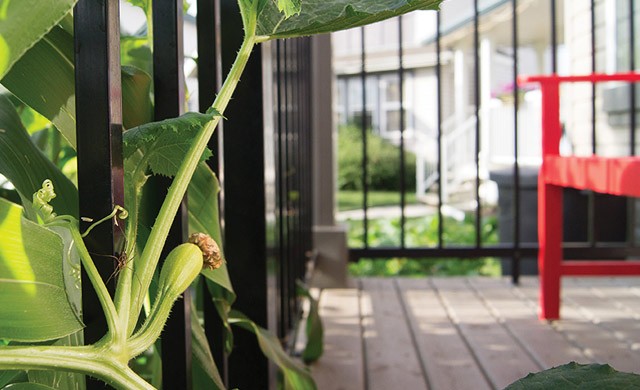
“We had water pooling in our front yard, there had been some settling and it looked really crappy,” says Paul Pearson. “At the same time my wife Suzanne, a Red Seal chef with a degree in environmental science, had started an organic day home. So we thought, let’s do something sustainable; let’s make a garden.
“We lasagna mulched with layers of cardboard, mushroom compost and cedar mulch, then put top soil where we wanted it. We grow apples, black and red currants, fennel, garlic, chives, artichokes and borage, rhubarb, stevia, mint, sage, oregano, lemon balm, zucchini, corn beans and squash together as the three sisters, strawberries, hot peppers, six different varieties of tomato, basil, parsley, winter kale, pansies, violets, nasturtiums, comfrey, and bergamot.We’re getting a lot of mileage out of a small plot.
“We have expanded our back garden too. Our kids grew what they like — Oscar, lettuce and spinach, and Anya, potatoes and carrots. “We spend about two hours a day in our gardens — the kids help. We share our harvest with the neighbours and we’ll can tomatoes and dry beans this year.”
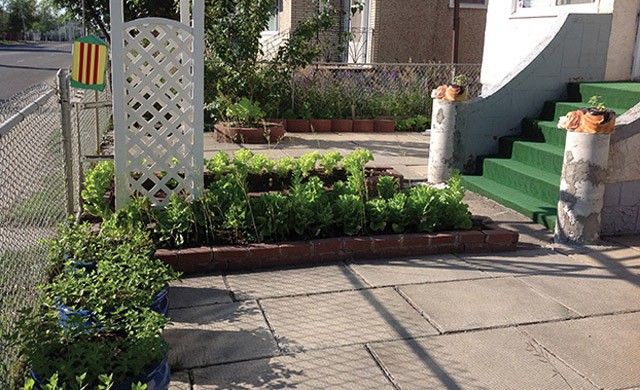
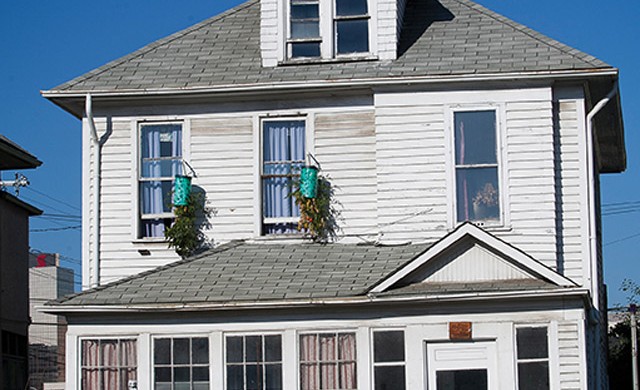
The Rooftop Garden
Mercer’s Catering has a large garden of planters and raised beds on the top floor of their operation in a north-end commercial space. “I plant as early as I can in May so we can have edible flowers all summer long,” says owner Jill Mercer. “I call it the garnish garden. We grow violas, nasturtiums, lots of mint and basil and other herbs, and tomatoes in planters and raised beds. My office and the tasting room are up there and look out on the garnish garden; sometimes we have client parties here. Wish it could be year round.”
Community Gardens
The University Farm Gardens (South Campus)
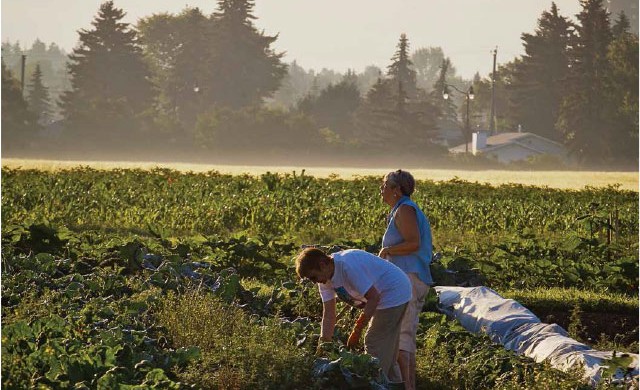
The Green & Gold Garden started as an idea to help do some good work in Africa. Now it’s a thriving two-acre garden that supports the Tubahumurize Association.
The garden is a joint project of the Faculty of Agricultural, Life and Environmental Sciences (ALES) and the University’s School of Public Health. Seeds, plants and equipment are donated; the labour is volunteer.
All the produce is sold by donation two nights a week and all of the donations are sent to Tubahumurize, a Rwandan non-profit that assists women with vocational training, life-skills coaching and opportunities for sustainable income generating activities.
The story of the Green & Gold Garden could be it takes a village to help a village.
The garden was founded in 2009 by Sarah Bowen, School of Public Health, and her husband Ed Parrada. Shirley Ross joined that spring.
“It combines two things for me;” says Shirley, “the joy I find in gardening and my interest in Africa, where I had lived for five years.”
On an early July morning the garden looks spectacular, the very definition of bountiful. While Johwanna the photographer sets up shots, volunteer Patti Hartnagel and I chat about her journey to the garden. “Actually, its funny,” she says. “I did a lot of peace education and after awhile, the older you get the more things repeat themselves. I was tired of not seeing any successes. I was tired of not knowing if it had any impact. So I shifted gears and got involved in starting the southwest farmers market. Which we did. Then I heard about Green & Gold at a community league meeting.
“We have about 65 active volunteers, an average of 20-25 on any given workday. Maureen Metz coordinates the volunteers, we have fabulous potlucks, and long table dinners in the garden.
“It’s bumper sticker wisdom, isn’t it,” she says, “think globally, act locally. The garden is thriving. In a little over five years we have sent $100,000 to Rwanda; we can see the good we’ve done to help women who have been through things we can only imagine, all through this wonderful produce, and it has broadened the whole community of people I’ve interacted with.
“Along with the garden we have built a community.”
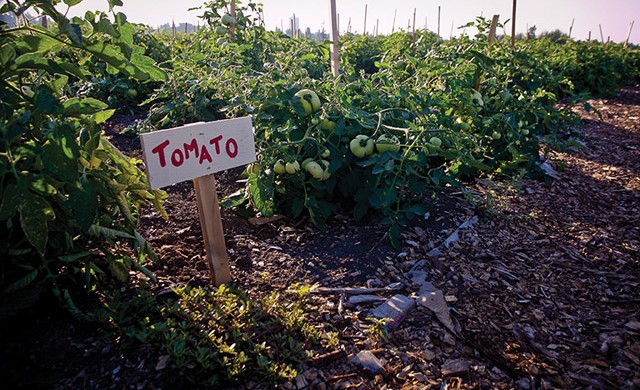
Just across the road in front of the old red barn is the Edmonton Organic Growers Guild Garden, worked by a low-key, loosely organized group of volunteers who share their produce amongst themselves and the Edmonton Food Bank.
Joining Green & Gold and the Growers Guild gardens on south campus is the Prairie Urban Farm. It’s a teaching garden, part of the Faculty of Agricultural Life and Environmental Sciences (ALES).
“U of A is a leader in agricultural sciences with the lions share of research grants generated in production agriculture. Some really big and important questions around sustainability tend not to get research attention,” says Dr. Debra Davidson, professor in the Department of Resource Economics and Environmental Sociology and the director of Prairie Urban Farm.
“Most of the land at the University Farm is not used for research,” Dr. Davidson says. Most of it is used to produce feed for the cows. Making hay is not the best use of this prime property.
“The garden was formed by a handful of academics who work in food security and urban sustainability; we decided we should be doing more than teaching classes and publishing papers. We envisioned something more active.
“This piece of land will take years to reach its ecological potential. We’ll build the soil, establish perennials and the social core, people working together.
“I would say that the Prairie Urban Farm represents a cornerstone of a new social movement around food,” says Dr. Davidson. “This is the way people are choosing to get active on political issues and agriculture and food security are political issues.”
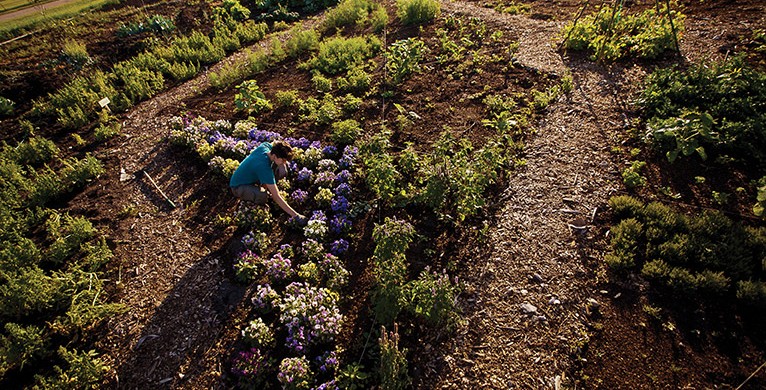
“I grew up gardening with my grandma during summers in Saskatchewan,” says Nicole Martin, project coordinator. “I’m able to combine my degree, which is ecology, and love of being outside with gardening.
The plan is to use regenerative agricultural practices such as sheet mulching and swale building, and to provide skill building opportunities, and ultimately to grow community resiliency through more local food. Our produce is shared among volunteers and food banks.
“It’s our first year and we’re learning a ton of new things. Our squash got powdery mildew so what do we do; we planted more tomatoes than perhaps we needed and had to figure in the time spent pruning and staking. We planted scarlet runner, royal burgundy and blue lake beans with our squash and corn and learned that with the three sisters (corn, beans, squash) it’s all about the timing.
“We have some folks who have been gardening for decades and their transfer of knowledge has been critical. And it’s happened in such an organic way; pulling carrots is where friendships are made.”
The Community Garden Experience
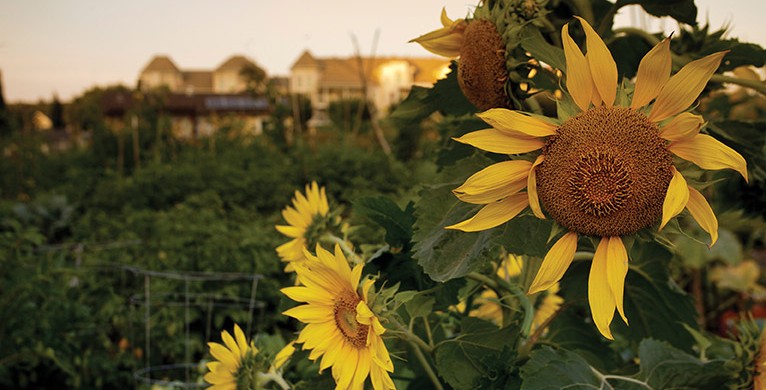
Many Edmontonians, possessed with the desire to garden, but either lacking the land or preferring a communal experience, have joined community gardens.
There are about 30 community gardens around the city — next door to community leagues, on church property, by apartments. Veterans of creating community gardens on city property say it can be a long, overly involved process that wears out groups before they have put spade to turf.
Amanda LeNeve’s experience has been a happy one. Amanda signed up for the Trinity Community Garden on the south side because she wanted a place where she could garden with others, close to home. “I had done my own thing in the past, sign up for a plot, grow your own and harvest your own,” says Amanda. “This time I wanted to garden in my community.
The commitment is $20 a year; you choose a crop to nurture once per week; I’m doing peas and beans, plus there is one work bee per month. We have peas, lots of beans, potatoes, lettuce, Swiss chard; we mounded the dirt for an herb spiral, we have flowers and kale in a beautiful jumble. It’s all sustainable, just bone meal, compost and water barrels.
“The church donated the land; I’m sure part of the intent was to make it beautiful for the community around it and to give gardeners within the neighbourhood a place to garden, but the garden is not directly affiliated with the church. There is a wide spectrum of interest and experience in the group — some are novices, some have taken permaculture courses, somebody is passionate about composting. During the work bees all this knowledge is shared.
“We have peas, lots of beans, potatoes, lettuce, Swiss chard; we mounded the dirt for an herb spiral, we have flowers and kale in a beautiful jumble. It’s all sustainable, just bone meal, compost and water barrels.
“It’s too easy to not be connected to your community when you live in a condo. I like feeling like part of the neighbourhood.”
Reading List
In Defense of Food by Michael Pollan
Food and the City by Jennifer Cockrall-King
All the Dirt by Rachel Fisher, Heather Stretch, Robin Tunnicliffe
Locavore by Sarah Elton